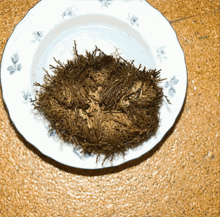| Revision as of 21:49, 26 December 2016 edit2605:a000:c180:3b00:c9c2:35f5:627:c677 (talk) →See also← Previous edit | Revision as of 22:54, 26 December 2016 edit undoPlantsurfer (talk | contribs)Extended confirmed users40,014 editsm Reverted 1 edit by 2605:A000:C180:3B00:C9C2:35F5:627:C677 (talk) to last revision by Bender the Bot. (TW)Next edit → | ||
| Line 27: | Line 27: | ||
| * ] | * ] | ||
| * '']'', the resurrection fern | * '']'', the resurrection fern | ||
| ================================================================== | |||
| The Resurrection Of The Resurrection Plant | |||
| The fabulous plant that grows in the valley of the Dead Sea on the edge of Jericho in the Judean Desert is called in Christianity the “Resurrection Plant” as it symbolizes the resurrection of Jesus. It is said that it was granted the gift of immortality when Maria placed a shroud belonging to her scared baby on it. The rose blossomed beside the sacred family while they fled to Egypt, it bloomed on the day of Jesus’ birth and dried up and closed at the time of his crucifixion and opened up again on Easter Day. | |||
| -------------------------------------------------------------------- | |||
| The Rose of Jericho from Dead Sea. | |||
| Jericho Rose has the amazing ability to preserve its seeds for years and to come to life again upon receiving water. Due to that quality it has been nicknamed “The Resurrection Plant” symbolizing the resurrection of Jesus. | |||
| The Resurrection Plant - Great gift for Christmas - roseofjericho.org | |||
| Adwww.roseofjericho.org/Christmas/Gift | |||
| The Rose of Jericho from Dead Sea. | |||
| ==References== | ==References== | ||
Revision as of 22:54, 26 December 2016
A resurrection plant is any poikilohydric plant that can survive extreme dehydration, even over months or years.

Examples include
- Anastatica hierochuntica, also known as the Rose of Jericho, a plant species native to deserts of North Africa
- Asteriscus (plant);
- Boea hygrometrica
- Haberlea rhodopensis
- Mesembryanthemum.
- Tillandsia
- Myrothamnus flabellifolius, a plant species native to Southern Africa
- Ramonda serbica, a species in the Gesneriaceae family
- Selaginella lepidophylla, a plant species native to North America, Central and South America, and sold as a novelty
- Lichen, a symbiosis that can survive in extreme desiccation
Certain resurrection plants have long been sold in their dry, "lifeless" form as curiosities. This custom was noted by many 19th century authors, and continues today.
In December, 2015, resurrection plants were featured in a TED talk given by Professor Jill Farrant , Molecular and Cell Biology, University of Cape Town, South Africa, who performs targeted genetic modification of crop plants to make them tolerate desiccation by activating genes that are already there but not natively expressed in response to drought.
See also
- Dehydration
- Cryptobiosis
- Anhydrobiosis
- Hygrochasy
- Pleopeltis polypodioides, the resurrection fern
References
- ^ Liberty Hyde Bailey (1916). The Standard Cyclopedia of Horticulture. Vol. 5. The Macmillan company. pp. 2920–2921, 3639.
- Zhang, T.; Fang, Y.; Wang, X.; Deng, X.; Zhang, X.; Hu, S.; Yu, J. (2012). Badger, Jonathan H (ed.). "The Complete Chloroplast and Mitochondrial Genome Sequences of Boea hygrometrica: Insights into the Evolution of Plant Organellar Genomes". PLoS ONE. 7 (1): e30531. doi:10.1371/journal.pone.0030531. PMC 3264610. PMID 22291979.
{{cite journal}}: CS1 maint: unflagged free DOI (link) - "Resurrection Plant". Faculty.ucc.edu. Retrieved 2012-01-30.
- "TED Speaker: Jill Farrant". TED.com. Retrieved 2016-01-21.
- "TED Talk: How we can make crops survive without water". TED.com. Retrieved 2016-01-21.
If an internal link led you here, you may wish to edit the linking article so that it links directly to the intended article.
This botany article is a stub. You can help Misplaced Pages by expanding it. |